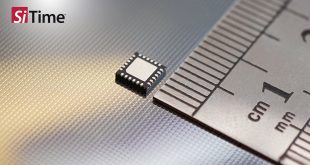In just a few weeks, the wait will be over. From March 28 to 30, 2017, LOPEC, the International Exhibition and Conference for the Printed Electronics Industry, will be taking place at the ICM—Internationales Congress Center München in Munich, Germany. Exhibitors from around the world will be presenting their new products covering the entire value chain. The spectrum ranges from conductive inks and innovative printers through to NFC tags, transparent solar cells and a whole host of other forward-thinking products.

Whether it is seat-occupancy sensors in cars, RFID labels or touch displays, more and more electric components are being produced using printing processes. The growing significance of printed electronics will be reflected at LOPEC 2017, emphasises Barbara Ismaier, exhibition director at Messe München: “We are expecting more than 150 exhibitors to attend LOPEC 2017. In order to cater for the huge interest in this area and provide sufficient room for the many new products, we even had to increase the exhibition space.”
Sensors, solar cells and smart packaging
Exhibitors will be demonstrating the innovation inherent to the printed electronics industry via a wide range of example applications. At LOPEC, French company ISORG and FlexEnable from UK will be presenting a wafer-thin, bendable optical sensor that can capture fingerprints with a resolution of 500 dpi. This can be integrated into smartphones, door openers and many other applications. As an additional security feature, the sensor also detects the equally unique blood vessel structure and, as such, can identify whether the fingerprint belongs to a living person.
In addition to sensor technology, photovoltaics is another sector which recognised the potential of printed electronics early on. CSEM Brasil and its spin-off company SUNEW will be presenting transparent, bendable organic solar cells for glass facades and other such elements at LOPEC. One example of this is CSEM Brasil’s artificial palm tree, which can be seen in the entrance area to the ICM. LOPEC visitors will have the chance to relax and charge up their smartphones under the leaves which contain integrated solar cells. This product innovation was developed for the “OE-A Competition”, an innovation contest run by the OE-A (Organic and Printed Electronics Association), the industry association that organises LOPEC together with Messe München.
NFC stands for near field communication, a contactless technology which is used to transfer data across a distance of a few centimetres to a smartphone or another mobile device. NFC labels made by Norwegian company Thinfilm, a pioneer in this area, connect real objects with the cloud. The company will be demonstrating at LOPEC how brand owners—from handbags to olive oil—are using this technology for their marketing activities.
There will also be printed electronics for on the go at the OE-A stand. The association has had 10,000 of these NFC tags printed, with one included in every copy of its new brochure. The tags will provide readers with additional information and prove that printed electronics has made the leap over to mass production.
Thinfilm’s range also includes temperature-sensitive labels for marking sensitive goods such as foods or medicines. Ludwigshafen-based chemicals group BASF will also be introducing an innovation in the area of smart packaging. Together with Heidelberg’s InnovationLab, BASF New Business has developed a label with a piezoresistive sensor and three LEDs, which gradually light up according to the pressure exerted.

Innovative materials and machines
These forward-thinking products are the result of ongoing collaboration between material scientists, mechanical engineers, and users. “LOPEC covers the entire value chain and provides information on all aspects, from research through to the final product,” underlines Barbara Ismaier. For this reason, leading plant manufacturers and suppliers of accessories such as printheads and screen printing stencils will be equally represented at LOPEC as material researchers and manufacturers of printing and encapsulation materials.
PV Nano Cell from Israel will also be using their visit to Munich as an opportunity to present the world’s first ink-jet ink with nano copper—a cost-effective yet efficient alternative to print materials with nano silver, which the company also offers. The nanoInk network, run by Nanoinitiative Bayern, will also be providing information in this area at LOPEC, while British company Haydale will, in turn, present their conductive ink based on the “wonder material” graphene. As part of an interdisciplinary research project alongside German mechanical engineering firm and fellow LOPEC exhibitor Saueressig, as well as other partners, Haydale has developed a printing machine for the complete production of biosensors. The system, which prints graphene and proteins onto a carrier material, includes specially structured gravure printing rollers for producing protein intaglios, a flexographic printing unit and a drying unit.
Other manufacturers also offer printing machines for specific purposes. These include German startup Notion Systems, who will be launching an ink-jet system for manufacturing organic LEDs (OLEDs) at LOPEC. The company has teamed up with LOPEC exhibitors M. Braun Inertgas-Systeme, a mechanical engineering company named Von Ardenne and the Fraunhofer Institute for Applied Polymer Research to develop the OLED printing process. Another highlight within the field of printing technology awaits visitors at the Pulse Electronics stand. The Finnish manufacturer will be demonstrating a device which can print antennas, sensors and much more onto three-dimensional objects.
Inspiration, information and valuable contacts
Even companies who are only just recognising the potential of printed electronics can visit LOPEC to gain inspiration, as well as garner information and benefit from opportunities to form new business relationships. For example, the Fraunhofer-Gesellschaft, Europe’s largest institution for application-oriented research, is an ideal potential partner for research and development, and will be represented at LOPEC alongside a number of different institutions. The VTT Technical Research Centre of Finland, US contract manufacturer GSI Technologies, the Japanese National Institute of Materials Science and many other institutions, from Germany and further afield, will be giving an insight into their work at LOPEC 2017.
“We are particularly pleased with the high level of international participation as this provides the perfect opportunity for global market orientation,” says Barbara Ismaier. About half of the exhibitors come from outside Germany—in total 17 different countries are represented. For the first time, companies from Portugal and Sweden will be showcasing their products and innovations to the international trade audience in Munich.
 CIE Components in Electronics
CIE Components in Electronics



